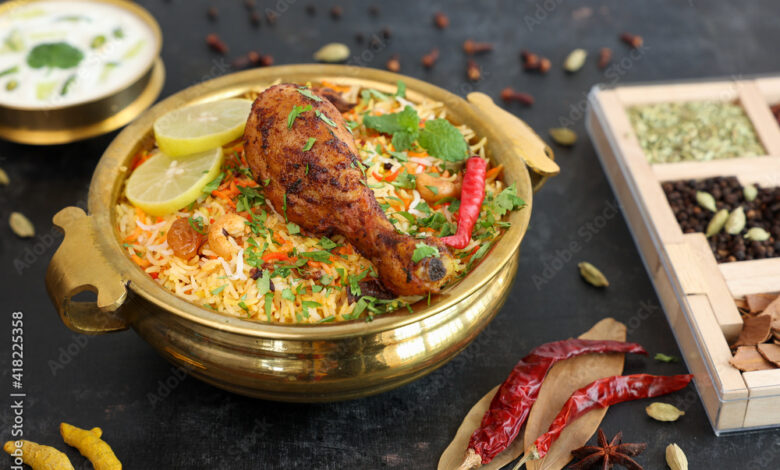Malabar Biryani Recipe
Malabar Biryani Recipe

Malabar Biryani Recipe Introduction:
Malabar Biryani is a traditional rice dish that blends the subtleties of Kerala’s cuisine with the robust flavors of biryani. The dish is a celebration of the region’s rich culinary heritage, marked by the intricate layering of rice and a richly spiced meat or vegetable mixture. Its origins can be traced back to the Muslim communities in the Malabar region, who adapted Persian biryani recipes to their local ingredients and taste preferences.
The preparation of Malabar Biryani typically involves marinating meat or chicken with a blend of yogurt and spices, then layering it with partially cooked basmati rice and slow-cooking the entire dish to allow the flavors to meld beautifully. The result is a fragrant, flavorful biryani with a perfect balance of spices, often garnished with fried onions, fresh herbs, and sometimes nuts and raisins.

Malabar Biryani Recipe Overview:
Malabar Biryani is a fragrant, spicy rice dish that hails from the Malabar region of Kerala, India. This biryani is known for its rich flavors and unique blend of spices, typically made with marinated meat or chicken, basmati rice, and aromatic spices. The dish is layered and slow-cooked, allowing the flavors to meld together beautifully.
Malabar Biryani Recipe Ingredients:
For the Marinade:
- 500 grams chicken or meat (beef/lamb), cut into pieces
- 1 cup yogurt
- 2 tablespoons ginger-garlic paste
- 2 tablespoons biryani masala or garam masala
- 1 teaspoon turmeric powder
- 1 teaspoon red chili powder
- Salt to taste
For the Rice:
- 2 cups basmati rice
- 4 cups water
- 2-3 bay leaves
- 4-5 green cardamom pods
- 4-5 cloves
- 1-inch cinnamon stick
- Salt to taste
For the Biryani:
- 2 large onions, thinly sliced
- 2-3 green chilies, slit
- 2 tomatoes, chopped
- 1 cup fresh mint leaves
- 1 cup fresh coriander leaves
- 1/4 cup ghee (clarified butter) or oil
- 1 teaspoon saffron strands (optional, soaked in 2 tablespoons warm milk)
- 1/2 cup fried onions (for garnish)
- 1/4 cup raisins (optional)
- 1/4 cup cashews (optional)
Malabar Biryani Recipe Ingredient Tips:
- Basmati Rice:
- Choose High-Quality Rice: Use long-grain basmati rice for the best texture and aroma. High-quality basmati rice will remain separate and fluffy when cooked.
- Soak the Rice: Soak the rice for at least 30 minutes before cooking to help it cook evenly and avoid it becoming mushy.
- Meat/Chicken:
- Marinate Well: Marinate the meat or chicken for at least 1 hour, or overnight if possible, to allow the flavors to penetrate deeply and tenderize the meat.
- Cut Evenly: Cut the meat into uniform pieces to ensure even cooking.
- Yogurt:
- Use Fresh Yogurt: Fresh yogurt works best for marinating as it tenderizes the meat and adds a tangy flavor.
- Avoid Sour Yogurt: Ensure the yogurt isn’t too sour, as it can affect the overall taste of the dish.
- Spices:
- Fresh Spices: Use freshly ground spices or freshly opened spice jars for the most potent flavor.
- Toast Spices: Lightly toasting whole spices like cardamom, cloves, and cinnamon before adding them to the dish can enhance their aroma.
- Onions:
- Fry Onions: Fry the onions until golden brown to add a rich, sweet flavor to the biryani. You can make extra fried onions for garnish.
- Uniform Slices: Slice the onions thinly and uniformly to ensure even cooking and browning.
- Herbs:
- Fresh Herbs: Use fresh mint and coriander leaves for the best flavor. Dried herbs won’t provide the same freshness and aroma.
- Chop Coarsely: Chop the herbs coarsely to release their essential oils and flavor into the biryani.
- Ghee/Oil:
- Ghee for Richness: Using ghee (clarified butter) adds a rich, nutty flavor to the biryani. If ghee is not available, you can use a neutral oil.
- Moderation: Use ghee or oil in moderation to avoid greasiness.
- Saffron:
- Quality Saffron: Use high-quality saffron strands for the best color and flavor. Soaking saffron in warm milk helps release its color and aroma.
- Optional: If saffron is not available, you can skip it, though it does add a beautiful color and subtle flavor.
- Layering:
- Alternate Layers: Alternate layers of rice and meat mixture to ensure even distribution of flavors.
- Rice on Top: Always finish with a layer of rice on top to prevent the meat from drying out.
- Cooking Method:
- Dum Cooking: Ensure the pot is sealed tightly during the dum (slow-cooking) process to trap steam and flavors. You can use dough to seal the edges of the lid if needed.
- Low Heat: Cook on low heat to allow the flavors to meld without burning the biryani.
Malabar Biryani Recipe Equipment Needed:
1. Large Mixing Bowl:
- For Marinating Meat/Chicken: Use this bowl to mix and marinate the meat or chicken with yogurt and spices.
2. Heavy-Bottomed Pot or Pressure Cooker:
- For Cooking the Biryani: A heavy-bottomed pot or pressure cooker ensures even heat distribution and helps prevent burning. If using a pressure cooker, avoid using the weight during the final dum cooking stage.
3. Rice Cooker or Large Pot:
- For Cooking Rice: If you don’t have a rice cooker, a large pot works well. Ensure it’s big enough to cook the rice without overcrowding.
4. Sieve or Colander:
- For Draining Rice: Use this to drain the partially cooked rice after boiling.
5. Frying Pan or Skillet:
- For Frying Onions: You’ll need this to fry onions until golden brown for the biryani and garnishing.
6. Small Pan or Bowl:
- For Saffron Milk: Use this to soak saffron strands in warm milk if you’re using saffron.
7. Sharp Knife and Cutting Board:
- For Chopping Ingredients: Essential for chopping onions, tomatoes, and herbs.
8. Measuring Cups and Spoons:
- For Accurate Measurements: Use these for measuring spices, yogurt, and other ingredients to ensure the right balance of flavors.
9. Wooden Spoon or Spatula:
- For Stirring: Ideal for stirring the rice and meat mixture without scratching your pot.
10. Tongs or Slotted Spoon:
- For Handling Rice and Meat: Use tongs or a slotted spoon to layer and serve the biryani.
11. Tight-Fitting Lid:
- For Dum Cooking: Ensure you have a tight-fitting lid to seal the pot during the slow cooking process. If necessary, use dough to seal the edges to trap steam.
12. Baking Dish (Optional):
- For Oven Method: If you prefer to use the oven for dum cooking, you’ll need a suitable baking dish or oven-safe pot.
13. Serving Dish:
- For Serving: A large serving dish or platter to present the Malabar Biryani.
14. Small Bowls for Garnishes:
- For Fried Onions, Raisins, and Cashews: These small bowls help organize your garnishes before adding them to the biryani.
Having the right equipment will make your cooking process smoother and help achieve the best results for your Malabar Biryani.
Step-by-Step Instructions:
- Marinate the Meat/Chicken:
- Prepare Marinade:
- In a large mixing bowl, combine 1 cup yogurt, 2 tablespoons ginger-garlic paste, 2 tablespoons biryani masala (or garam masala), 1 teaspoon turmeric powder, 1 teaspoon red chili powder, and salt to taste.
- Marinate Meat:
- Add 500 grams of chicken or meat (beef/lamb), cut into pieces, to the marinade.
- Mix well to coat the meat thoroughly.
- Cover and refrigerate for at least 1 hour, or overnight for best results.
- Prepare the Rice:
- Rinse and Soak Rice:
- Rinse 2 cups basmati rice under cold water until the water runs clear.
- Soak the rice in water for 30 minutes, then drain.
- Cook Rice:
- In a large pot, bring 4 cups of water to a boil.
- Add 2-3 bay leaves, 4-5 green cardamom pods, 4-5 cloves, 1-inch cinnamon stick, and salt to taste.
- Add the soaked rice and cook until it is 70% cooked (parboiled). The rice should still be slightly firm.
- Drain and set aside.
- Cook the Meat:
- Sauté Onions and Chilies:
- Heat 1/4 cup ghee (clarified butter) or oil in a large pan over medium heat.
- Add 2 large onions, thinly sliced, and 2-3 slit green chilies. Sauté until the onions are golden brown.
- Cook Tomatoes:
- Add 2 chopped tomatoes to the pan. Cook until they soften and blend into the onion mixture.
- Add Marinated Meat:
- Add the marinated meat to the pan. Cook until the meat is browned and cooked through. Stir occasionally.
- Layer the Biryani:
- Start Layering:
- In a heavy-bottomed pot or pressure cooker, spread a layer of the cooked meat mixture at the bottom.
- Add Rice:
- Add a layer of the partially cooked rice over the meat. Spread it evenly.
- Add Herbs and Spices:
- Sprinkle 1 cup of fresh mint leaves and 1 cup of fresh coriander leaves over the rice.
- Repeat the layering process, finishing with a layer of rice on top.
- Garnish:
- Drizzle 1 teaspoon of saffron strands (soaked in 2 tablespoons warm milk) over the top layer of rice.
- Garnish with 1/2 cup of fried onions, and optionally 1/4 cup of raisins and 1/4 cup of cashews.
- Dum Cooking (Slow Cooking):
- Seal the Pot:
- Cover the pot with a tight-fitting lid. If necessary, use dough to seal the edges to trap steam.
- Cook on Low Heat:
- Cook on very low heat for 20-30 minutes. This allows the flavors to meld and the rice to finish cooking.
- Alternative: Preheat your oven to 180°C (350°F) and place the sealed pot in the oven for the same duration.
- Serve:
- Fluff the Biryani:
- Gently fluff the biryani with a fork to mix the layers without breaking the rice grains.
- Garnish and Serve:
- Transfer to a serving dish.
- Serve hot with raita (yogurt-based side dish), pickle, and salad.
Enjoy your homemade Malabar Biryani! This flavorful dish is perfect for special occasions and family gatherings.
Tips and Tricks:
- Choosing Ingredients:
- Basmati Rice: Opt for high-quality basmati rice for the best texture and aroma. Long-grain basmati rice is ideal as it cooks up fluffy and separates well.
- Fresh Spices: Use freshly ground spices or freshly opened jars of spices for a more aromatic biryani. Whole spices like cardamom, cloves, and cinnamon should be toasted lightly to enhance their flavor.
- Marinating the Meat:
- Marinate Overnight: For maximum flavor and tenderness, marinate the meat or chicken overnight. If short on time, marinate for at least 1 hour.
- Yogurt Consistency: Use fresh, thick yogurt for the marinade. If your yogurt is too watery, it might not coat the meat well.
- Cooking the Rice:
- Pre-cook Carefully: Boil the rice until it is 70% cooked (parboiled). Overcooking the rice at this stage can lead to mushiness after the final dum.
- Flavor the Water: Add bay leaves, cardamom, cloves, and cinnamon to the boiling water to infuse the rice with subtle spices.
- Frying Onions:
- Uniform Slices: Slice the onions uniformly for even frying. Thin slices fry more evenly and become crispier.
- Golden Brown: Fry onions until they are deep golden brown but not burnt. This adds a sweet and rich flavor to the biryani.
- Layering the Biryani:
- Even Layers: Layer the rice and meat mixture evenly to ensure that flavors are distributed throughout. Avoid overloading any single layer.
- Garnishing: Reserve some fried onions, mint, and coriander for garnishing on top of the final rice layer.
- Dum Cooking (Slow Cooking):
- Seal the Pot: Ensure the pot is sealed well to trap steam. Use dough to seal the edges if needed to ensure no steam escapes.
- Low Heat: Cook on very low heat to allow the flavors to meld and the rice to absorb the spices without burning.
- Saffron:
- Saffron Quality: Use high-quality saffron strands for the best color and flavor. If saffron is unavailable, you can skip it or use a pinch of yellow food coloring as a substitute.
- Soaking: Soak saffron strands in warm milk to release their color and aroma before drizzling over the biryani.
- Serving:
- Resting Time: Let the biryani rest for 10-15 minutes after cooking before serving. This helps the flavors to settle and makes mixing easier.
- Fluffing: Gently fluff the biryani with a fork before serving to separate the rice grains and mix in the layers without breaking them.
- Additional Tips:
- Add Vegetables: For a more wholesome biryani, you can add vegetables like potatoes or carrots in the meat layer.
- Adjust Spice Levels: Adjust the amount of chili powder and green chilies based on your heat preference.
- Side Dishes: Serve Malabar Biryani with raita (yogurt sauce), pickles, and salad to complement the dish.
These tips and tricks will help you achieve a flavorful, aromatic Malabar Biryani that’s sure to impress your family and guests. Enjoy your cooking!
Serving Suggestions:
1. Raita:
- Mint Raita: A refreshing yogurt-based side dish with chopped mint leaves, cucumber, and a hint of cumin. It provides a cooling contrast to the spicy biryani.
- Onion Raita: Yogurt mixed with finely chopped onions, green chilies, and coriander leaves. This adds crunch and freshness.
2. Pickles:
- Mango Pickle (Aam ka Achaar): A tangy and spicy pickle that pairs well with the rich flavors of biryani.
- Lemon Pickle: Offers a zesty flavor that complements the biryani’s spices.
3. Salad:
- Cucumber and Tomato Salad: A simple salad with sliced cucumbers, tomatoes, and onions, seasoned with lemon juice, salt, and pepper.
- Kachumber: A mixed vegetable salad with cucumber, tomato, onion, and a squeeze of lemon juice. It’s refreshing and light.
4. Hard-Boiled Eggs:
- Eggs as Garnish: Hard-boiled eggs, sliced in half or whole, can be placed on top of the biryani or served on the side. They add richness and a bit of protein.
5. Additional Garnishes:
- Fried Onions: Extra fried onions can be used as a garnish for added crunch and sweetness.
- Cashews and Raisins: Garnish with toasted cashews and raisins for a touch of sweetness and texture contrast.
6. Side Dishes:
- Shorba: A light, spiced soup or broth served alongside can complement the biryani and cleanse the palate.
- Kerala-style Curry: Serve with a side of vegetable or meat curry for a more elaborate meal.
7. Accompaniments:
- Papadam: Crispy, fried papadam (poppadoms) can be served as a crunchy side.
- Chapati or Naan: Although not traditional, these can be served alongside for those who prefer bread with their meal.
Serving Tips:
- Presentation: Serve the biryani in a large, flat serving dish to showcase the layers and garnishes.
- Serving Temperature: Biryani is best enjoyed hot or warm. If reheating, do so gently to avoid drying out the rice.
- Portioning: Serve generous portions of biryani, and ensure each plate has a good mix of rice and meat.
FAQs:
1. Can I use other types of rice instead of basmati?
Answer: While basmati rice is traditionally used for its aroma and long grain, you can use other types of rice if necessary. However, using non-basmati rice, like jasmine or regular long-grain rice, may alter the texture and flavor of the biryani. Basmati rice is preferred for its ability to stay fluffy and separate, which is key to achieving the perfect biryani.
2. Can I make Malabar Biryani with vegetables instead of meat?
Answer: Yes, you can make a delicious vegetarian version of Malabar Biryani. Substitute the meat with a mix of vegetables such as potatoes, carrots, beans, and peas. For added protein, you can include paneer (Indian cottage cheese) or tofu. Adjust the cooking time accordingly, as vegetables cook faster than meat.
3. How can I make Malabar Biryani spicier or milder?
Answer: To adjust the spiciness of your Malabar Biryani, you can:
- Increase Spiciness: Add more red chili powder, green chilies, or a bit of extra biryani masala.
- Reduce Spiciness: Use less chili powder and fewer green chilies. You can also add more yogurt to mellow out the heat.
4. Can I prepare Malabar Biryani in advance?
Answer: Yes, you can prepare Malabar Biryani in advance. You can cook the biryani a day before serving and refrigerate it. Reheat gently on the stovetop or in the oven to avoid drying out the rice. If reheating in the oven, cover the pot with foil to retain moisture.
5. What is the best way to reheat Malabar Biryani without losing flavor or texture?
Answer: To reheat Malabar Biryani effectively:
- Stovetop: Gently reheat in a covered pan over low heat, adding a few tablespoons of water to prevent it from drying out. Stir occasionally to ensure even heating.
- Oven: Preheat the oven to 180°C (350°F). Place the biryani in an oven-safe dish, cover with foil, and heat for 20-30 minutes. This method helps to maintain moisture and texture.




